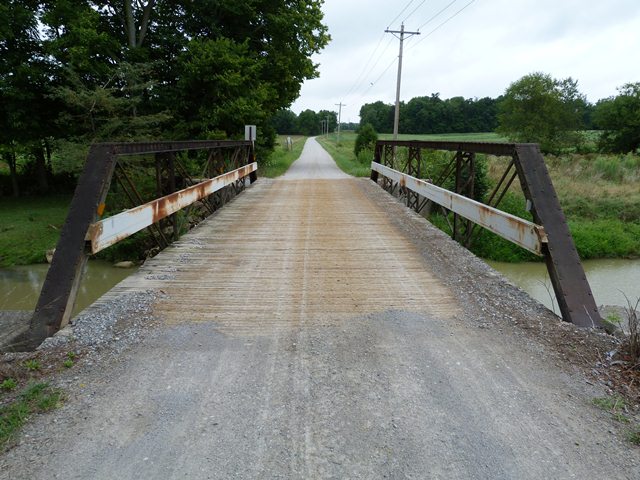We Recommend:
Bach Steel - Experts at historic truss bridge restoration.
BridgeHunter.com Phase 1 is released to the public! - Visit Now
Ruggles Road Bridge

Primary Photographer(s): Nathan Holth
Bridge Documented: August 11, 2012
Rural: Morrow County, Ohio: United States
By Builder/Contractor: Massillon Bridge Company of Massillon, Ohio
2005
49.0 Feet (14.9 Meters)
50.0 Feet (15.2 Meters)
13.8 Feet (4.21 Meters)
1 Main Span(s)
5933048

View Information About HSR Ratings
Bridge Documentation
View Archived National Bridge Inventory Report - Has Additional Details and Evaluation
This bridge is a traditionally composed example of a pin-connected pony truss. It retains good historic integrity, with the only substantial alteration being the replacement of the original railings. The Historic Bridge Inventory says that the floorbeams were replaced in-kind in 2005. The floorbeams on the bridge look old (they are rusted similarly to the rest of the truss) and are American Standard Beams, not modern wide flange beams. If they really are replacements, they must have been salvaged from another bridge. It is also possible that the "floorbeams" that the Historic Bridge Inventory refers to are actually the deck stringers. The deck stringers do look fairly new, and it would not be unusual for them to be replaced as part of a deck repair.
Information and Findings From Ohio's Historic Bridge InventorySetting/Context The bridge carries a 1 lane, unimproved road over a stream in a rural area of active farms. Physical Description The 1 span, 50'-long, pin-connected Pratt pony truss bridge is supported on concrete abutments. The trusses are traditionally composed of built-up compression members and eyebar tension members. There are no unusual details, but the bridge is wrought iron with some cast pieces, like the seats. Additional material has been welded to the end posts and upper chords. Floorbeams replaced in kind in 2005. Integrity Impacted rust and some welded repairs in the usual places. Summary of Significance The pin connected Pratt pony truss bridge dated stylistically to ca. 1888 is one of 20 examples of the important bridge type in Morrow County with the oldest extant example dating to 1874. Many are undocumented
and represent the era of standardization. This example is attributed to the Massillon Bridge Co., who sold many truss bridges to the county. Bridge Considered Historic By Survey: No |
![]()
Photo Galleries and Videos: Ruggles Road Bridge
Bridge Photo-Documentation
Original / Full Size PhotosA collection of overview and detail photos. This gallery offers photos in the highest available resolution and file size in a touch-friendly popup viewer.
Alternatively, Browse Without Using Viewer
![]()
Bridge Photo-Documentation
Mobile Optimized PhotosA collection of overview and detail photos. This gallery features data-friendly, fast-loading photos in a touch-friendly popup viewer.
Alternatively, Browse Without Using Viewer
![]()
Southbound Crossing
Full Motion VideoStreaming video of the bridge. Also includes a higher quality downloadable video for greater clarity or offline viewing.
![]()
Maps and Links: Ruggles Road Bridge
Coordinates (Latitude, Longitude):
Search For Additional Bridge Listings:
Bridgehunter.com: View listed bridges within 0.5 miles (0.8 kilometers) of this bridge.
Bridgehunter.com: View listed bridges within 10 miles (16 kilometers) of this bridge.
Additional Maps:
Google Streetview (If Available)
GeoHack (Additional Links and Coordinates)
Apple Maps (Via DuckDuckGo Search)
Apple Maps (Apple devices only)
Android: Open Location In Your Map or GPS App
Flickr Gallery (Find Nearby Photos)
Wikimedia Commons (Find Nearby Photos)
Directions Via Sygic For Android
Directions Via Sygic For iOS and Android Dolphin Browser
USGS National Map (United States Only)
Historical USGS Topo Maps (United States Only)
Historic Aerials (United States Only)
CalTopo Maps (United States Only)


